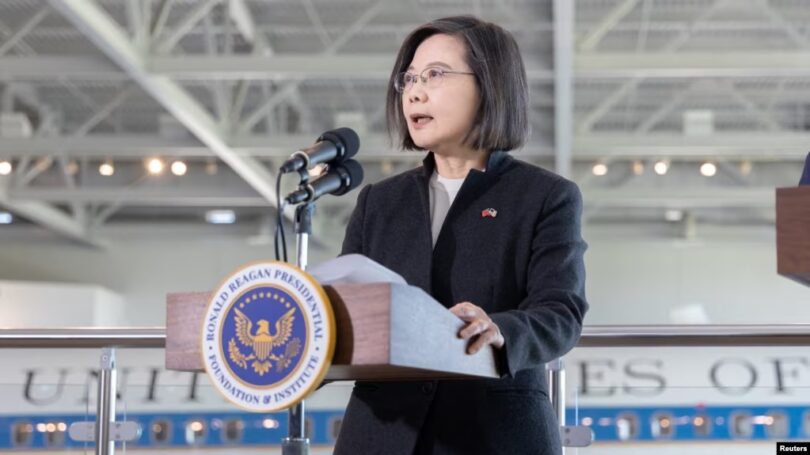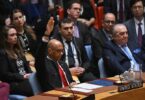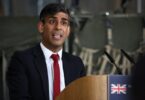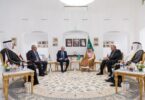Cindy Sui
When Taiwan’s former and current presidents each embarked on overseas trips this month, their travels highlighted how rising tensions between the United States and China are seen by the islands’ voters who will pick a new leader in January. President Tsai Ing-wen met with US House Speaker Kevin McCarthy and other American legislators during stops in New York and California. Around the same time, Tsai’s predecessor, former President Ma Ying-jeou became the first Taiwanese former or current president to visit China since the two sides were separated at the end of the Chinese civil war in 1949.
Generally, Tsai’s Democratic Progressive Party supports Taiwanese nationalism and has championed building diplomatic ties with the US and other nations. Ma’s Kuomintang party generally favors building ties with Beijing, as well as with the US and other nations, and trying to find consensus. Opinion polls conducted after the trips among Taiwanese adults 20 years and older found some 61% reported approving of Tsai’s meeting with McCarthy while 22% disapproved. Ma’s trip found opinions more evenly split, with some 39% of respondents saying they approved, and 43% disapproving.
Tsai, her ruling Democratic Progressive Party known as the DPP, and their supporters see the meeting with McCarthy as an example of Taiwan’s right to conduct diplomacy and an important step for Taiwan’s security. “In the face of pressure and intimidation, the people of Taiwan will only become more united,” she said according to Taiwan’s Central News Agency, adding that her meetings with the American legislators “will contribute to cross-Taiwan Strait stability and regional peace.”
Soong Hseik-wen, an international affairs professor at Taiwan’s National Chung Cheng University, said Tsai’s visit will help her party with voters. “It shows that globally, countries like the US accept Taiwan’s [de facto] independence,” Soong said. “In the future, there will be many countries that support democracy, freedom and human rights, including the EU, the US, Canada, Japan, and even South Korea, Southeast Asian countries that will stand with Taiwan.” Former President Ma Ying-jeou had a different goal for his lower-key journey to China, a “private” visit he made as a citizen, not as a former president, that saw him bring college students and academics for exchanges, to promote more interaction between the two sides as a way of reducing tensions. Ma remains influential after serving two terms in office from 2008 to 2016 at a time when he improved relations with Beijing without losing Taiwan’s self-rule, freedoms and democracy.
On his “peace-building” mission this month, Ma told reporters, “the two sides must pursue peace, otherwise both sides will not have a future.” Tso Chen-dong, a National Taiwan University political science professor said Ma’s visit shows that when the two sides have regular contact, they can gain a better understanding about each other, which can help them out of the current “hostility spiral.” “If the two sides continue to hold a negative view of each other, then they are moving towards a collision,” Tso said. “However, if they can change their perception through mutual exchanges, little by little, the collision can be slowed down and even reversed.”
While surveys indicated most Taiwanese support Tsai’s US visit, some voters worried that embracing Americans could further raise tensions with China. “Tsai keeps going overseas to win over the US and promote her anti-China agenda and then China carries out these military activities. This is not what we want,” said Yen Hsiao-lien, who told VOA by phone that she worries her two sons will be drafted into a combat situation. “The median line (in the Taiwan Strait) is gone” Yen said, referring to the more than 100 Chinese warplanes that crossed the invisible line between the two sides in response to Tsai and McCarthy’s meeting. “Tsai’s supporters think she’s doing great and more countries are now paying attention to Taiwan, but practically the whole world recognizes (there’s only) one China.” She was referring to the fact that almost all countries except 13 nations in the world recognize the mainland as China and do not treat Taiwan as a country or have formal diplomatic relations with the island, although many have close informal ties with Taipei.
Washington adopted the “One China Policy” in 1979 when it switched diplomatic recognition from the Republic of China (Taiwan) to the mainland People’s Republic of China. Under this policy, Washington acknowledges but does not accept Beijing’s claim that Taiwan is a part of China to be reunified one day, preferring that the two sides reach a peaceful resolution, and urging both not to take unilateral actions that change the status quo. The One China Policy is not the same as the One China principle, under which Beijing asserts Taiwan and the mainland are part of one country to be reunited one day. Splits over what sort of status and relationship Taiwan should have with China continue to divide voters such as Helen Ko, a 30-year-old law student who said she will not vote for the Kuomintang because its concept of “country” encompassing the mainland and Taiwan, “is not my definition.” She prefers the DPP’s approach of seeking international support.
“Let’s say the whole world thinks Taiwan is very democratic … and recognizes Taiwan’s importance. Could this prevent China from attacking us? If so, the United States, Germany and everyone can come and protect us,” Ko said. Analyst Tso, however, cautioned against underestimating Beijing’s determination to safeguard what it sees as its territorial integrity. Even if unification is not a top priority for Beijing now, it has vowed to crush moves toward formal independence. Beijing sees the two sides as part of one country to be reunified one day and has not renounced the use of force to do so. But Tso said it was encouraging that the US administration seems to be aware of the need to maintain the balancing act between Beijing and Taipei’s concerns, despite the difficulties in doing so. “Those in the US who hope to prevent a collision between the US and China are still mainstream opinions in policy circles.” said Tso. “That gives people hope that the two sides can prevent any risk-taking action from really causing a collision.”
VOA







